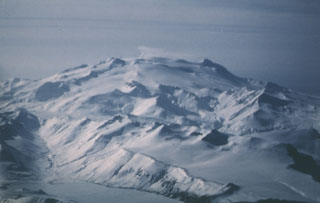Report on Makushin (United States) — July 1980
Scientific Event Alert Network Bulletin, vol. 5, no. 7 (July 1980)
Managing Editor: David Squires.
Makushin (United States) Recently-ejected tephra; vapor emission
Please cite this report as:
Global Volcanism Program, 1980. Report on Makushin (United States) (Squires, D., ed.). Scientific Event Alert Network Bulletin, 5:7. Smithsonian Institution. https://doi.org/10.5479/si.GVP.SEAN198007-311310
Makushin
United States
53.891°N, 166.923°W; summit elev. 1800 m
All times are local (unless otherwise noted)
On 8 July, J. Hauptmann, G. Gunther, and R. [Steuer] visited a seismic station on the E flank and overflew the summit. More than ten roughly circular vents emitted vapor from the summit area, a flat region about 100 m across. The largest vent was about 30 m in diameter, and others were around 10 m across. An H2S odor was detected, but no ash or incandescent material was observed.
About 60 m below the summit on the S flank, an explosion vent had recently ejected tephra ranging in size from ash to blocks, deposited in streaks aligned roughly toward the SE. Some impact craters were present in the deposit area, which extended 30-60 m from the vent.
Geological Summary. The ice-covered Makushin volcano on northern Unalaska Island is capped by a 2.5 km caldera. Its broad, dome-like structure contrasts with the steep-sided profiles of most other Aleutian stratovolcanoes. Much of the edifice was formed during the Pleistocene, but the caldera (which formed about 8,000 years ago), Sugarloaf cone on the ENE flank, and a cluster of about a dozen explosion pits and cinder cones at Point Kadin on the WNW flank, are of Holocene age. A broad band of NE-SW-trending vents cuts across the volcano. The composite Pakushin cone, with multiple summit craters, lies 8 km SW. Table Top (Pleistocene, 68 +/- 14 ka) and Wide Bay (Holocene) cinder cones are about 20 km ENE on the peninsula across the bay from the City of Unalaska. Frequent explosive eruptions have occurred during the past 4,000 years, sometimes accompanied by pyroclastic flows and surges. Geothermal areas are found in the summit caldera and on the SE and E flanks. Small-to-moderate explosive eruptions have been recorded since 1786.
Information Contacts: J. Hauptmann, G. Gunther, R. Steuer, and S. McNutt, Lamont-Doherty Geological Observatory (LDGO).

